TSA Weekly, April 6 - 10, 2009

News
- Collaboration and Understanding Key at TSA Training
- Breakfast With Bob: ‘OLE/FAMS Employee Participation Makes the Difference’

- Evolution Pilot’s Goal Is Enhanced Performance
- A Colleague’s Best Practices Complement Evolution
- Evolution: In the FSD's Own Words
More News
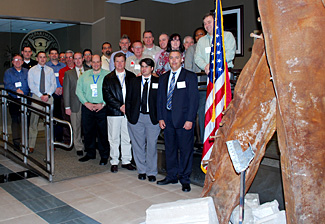
At TSA’s Freedom Center, participants in the agency’s first-ever Field Coordination Center Managers Training Seminar stand next to the 9/11 memorial. Read more. Photo by Michael Houde

Graphic by Ann Oh
Your Weekly E-mail Tip
If you are running out of space in your TSA e-mail account, you may want to check your folders for large messages and other information that are taking up space. Officers are currently provided a 20 megabyte (MB) mailbox. Messages and information contained in the following folders count against your mailbox size: calendar, contacts, deleted items, drafts, inbox, notes, outbox, sent items, tasks and any subfolder under your Outlook Today folder hierarchy. Keeping these folders current will help keep your mailbox under the 20 MB limit.

Editor’s Note: Acting Administrator Gale Rossides recently identified collaboration as being critical to carrying out TSA’s mission. The following two stories are the first in an occasional series on collaboration.
Collaboration and Understanding Key at TSA Training
By Jennifer Morrow, executive assistant, Transportation Security Operations Center
Communication and the exchange of best practices were forefront at TSA’s first-ever Field Coordination Center Managers Training Seminar at the agency’s Transportation Security Operations Center (TSOC) in Virginia.
The TSOC, located at the Freedom Center facility, is the central operations and information-gathering point for TSA across the nation.
The training provided briefings on several critical disciplines, including contingency operations and report writing, and offered participants an opportunity to learn firsthand about the TSOC. Discussions covered issues such as Field Coordination Center training for watch officers; standardized reporting processes across TSA; and standardized tools. Employees also shared best practices that included field-designed processes and forms structure; Field Coordination Center internal reporting; and Watch standards.
The training, a collaborative effort between Security Operations and the Office of Law Enforcement/Federal Air Marshal Service (OLE/FAMS), was held in March and early April.
“The training was excellent,” said Curt Cooper, manager, Continuation of Operation, Minneapolis-St. Paul International Airport. “It allowed those of us in the field to link with headquarters and leadership, and helped the field coordination centers ‘connect the dots’ on operations."
Those visiting said they were moved by the 9/11 memorial featured in the TSOC lobby: a twisted steel girder from the 72nd floor of the World Trade Center that is surrounded by a bed of sandstone blocks from the impact site at the Pentagon, along with a piece of United Flight 93’s fuselage.
“It’s very moving to stand in front of this amazing structure; its silence says so much about what we do,” said Gary Holdsworth, manager, Coordination Center at Sacramento (Calif.) International Airport.
With reporting from FSD Jay Brainard, Iowa; Deputy Assistant Director Kent Jefferies, OLE/FAMS Operations; Liaison Manager Ron Juhl, Security Operations; and FSD Steve Pansky, Reno/Tahoe (Nev.) International Airport.
Breakfast with Bob: ‘At OLE/FAMS, Employee Participation Makes the Difference’
An Interview with Assistant Administrator Bob Bray
By Mary Ally, internal communications manager, Office of Law Enforcement/Federal Air Marshal Service
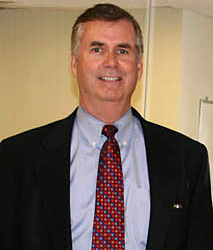
Assistant Administrator Bob Bray Photo by Nelson Minerly
It's hard to believe that in just three short years, OLE/FAMS has achieved a cultural transformation widely considered unprecedented for a law enforcement agency.
During that time, the entire leadership team has been directly engaged in soliciting employee ideas using multiple approaches. And now, Assistant Administrator Bob Bray can characterize today's OLE/FAMS as "more open, inclusive, responsive and capable of assuming any challenge."
The OLE/FAMS leadership team pulls out all the stops to listen to the workforce, understand their issues, and implement their suggestions. Big improvements have resulted, ranging from the process for scheduling FAMs to fly missions to approving a smaller weapon for FAMs who have smaller hands. The latter change is of particular benefit to women who, as a result, achieved higher firearms re-qualification scores.
Here's how this engagement process works: Employees identify operational and administrative targets for improvement; voice their ideas for workable, practical solutions; and participate in teams to develop implementation plans.
According to Bray, "This winning model has advanced important tactical operations and quality-of-life protocols."
Therefore, it came as no surprise that GAO recently rendered a very favorable performance audit of OLE/FAMS management and operations. These findings track with the strides the organization has made to become one of the most mobile, flexible, and vigilant federal law enforcement agencies in the country. The GAO Report is accessible by clicking this link.
Impressively, GAO found that over a quarter of the workforce actively participated in one or more employee outreach initiatives to make their ideas count in revamping sensitive operational protocols. These "big ticket" items include modifying the FAM dress code, streamlining boarding procedures to preserve FAM anonymity, and dramatically improving mission scheduling without degradation to mission tempo.
"We can thank former Assistant Administrator Dana Brown for laying the foundation for these candid conversations, which culminated into 36 working groups, town hall meetings, field office visits, weekly informal dinners with federal air marshals, and employee suggestions to the anonymous internet suggestion box," said Bray.
The assistant administrator and his team continue to add new dimensions, too, including quarterly listening sessions with employees; launching a new OLE/FAMS Advisory Council to identify and implement priority improvements; and hosting informal breakfasts for FAMs transiting through the Washington metropolitan area.
FAMs find "Breakfast with Bob" especially appealing. Over a cup of coffee, FAMs directly engage the assistant administrator in frank discussions.
"Everything is on the table and actions are immediate," he explained. "I have enormous respect and gratitude to all who participate in improving our organization. Their valued contributions demonstrate that they care about what they do, about the mission."

Evolution Pilot’s Goal is Enhanced Performance
By Benjamin Coleman, Evolution Team
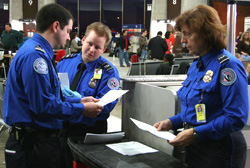
At Ronald Reagan Washington National (from left) are Supervisory TSO Justin Rinck, TSOs John Clagett and Barbara Murphy.
Photo by Hanser Hernandez
The Evolution Team is conducting a communications pilot at 11 airports nationwide that introduces two tools designed to enhance workforce performance: My Evolution Resolution and Evolution Scenarios. The pilot began Feb. 15 and will end April 11.
My Evolution Resolution is a short message delivered through the National Shift Brief that gives the workforce a weekly theme and actionable items to put into practice. The resolution is designed to reinforce principles taught in COACH! and ENGAGE!.
Evolution Scenarios takes real life situations from everyday life in an airport and puts them into the See-Feel-Think-Do model taught in ENGAGE!. This tool is designed to help officers build critical thinking skills and awareness for the challenges that they may one day face.
"This pilot program has been a great way to determine the best way to keep Evolution fresh in everyone's mind,” said Colin O’Hanlon, supervisory TSO, Newark (N.J.) Liberty International Airport. “It is a big step towards making sure that Evolution becomes a way of life for our agency, not just some epic event."
After completion of the pilot, the Resolutions and Scenarios will be implemented at airports nationwide so each employee has the tools to build stronger teams and mitigate the threat. The Resolutions will deploy nationally on May 3 and the Scenarios will deploy in phases beginning in the summer.
If you are interested in offering the Scenarios at your airport, please let your airport leadership know and they can contact the Evolution Support Center at checkpointevolution@dhs.gov.
The 11 participating airports are Ronald Reagan Washington National, Los Angeles International, Antonio B. Won Pat Guam International, Ketchiken (Alaska), Piedmont Triad International (Greensboro, N.C.), Chicago Midway, Capital City (Lansing, Mich.), Indianapolis International, Gallatin Field (Belgrade, Mont.), Newark and Seattle-Tacoma International.
A Colleague’s Best Practices Complement Evolution
(PDF, 137kb)Editor’s Note: The article’s author, Al Wong, who recently retired as the customer support and quality improvement manager at Phoenix Sky Harbor International Airport, passed away on Feb. 19.
Evolution: In the FSD's Own Words
We continue to see positive changes on the “A-Team” from the ENGAGE! program with its constructive impact on our teamwork, camaraderie and reduced noise levels. Through continuous reinforcement and refreshing of ENGAGE! basics from our leadership team, the TSOs have truly demonstrated a more involved approach to their work, a greater sense of awareness and active participation in the security environment. – FSD Corky Caldwell, Anchorage (Alaska) International Airport
Engage the Evolution team with your questions and suggestions at ENGAGEevolution@dhs.gov.
News
Conficker C – Business as Usual for TSA’s Network Protectors
By Nicole Raymond, communications team, Office of Information Technology

Graphic courtesy of the Office of Information Technology
While the Conficker C worm threat loomed over the world’s computer users last week, TSA’s Office of Information Technology (OIT) took the challenge in stride.
“Our IT Security and Solutions Delivery divisions have been preparing for the Conficker threat for months,” said Acting Chief Information Officer Stephen Rice. “Working with DHS and industry partners, we prepared for this as diligently as we do for any serious IT security threat, only this one had much greater public notoriety.”
Conficker C was estimated to have infected roughly 12 million computers worldwide, turning each infected machine into a potential zombie that could be used to gather private information. To prevent any impact to TSA computers, OIT patched the Microsoft Windows vulnerability and updated anti-virus and network intrusion detection software throughout the network.
On April 1, when Conficker C was to activate, IT Security staff at the TSA Security Operations Center (SOC) actively monitored the network – which includes more than 20,000 computer systems – for any malicious events related to the worm.
“We were confident that our preventative actions would keep the network secure, but we were also prepared to quarantine any infected machine, if necessary,” said Chief Information Security Officer Richard Smith.
As it turned out, there was only one Conficker-related event. “To put it in context, we monitor over a billion events per week from our TSA SOC, with roughly ten rising to the level that would constitute an actual security incident,” said Smith.
TSA’s Injury Rates Continue to Decline
By Lynn Dean, InfoCenter
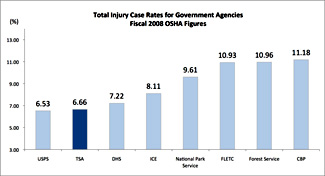
Graphic by Brigitte Dittberner
TSA’s injury rates have declined over the years, and the trend is continuing with rates decreasing 75 percent from fiscal 2004 through 2008.
According to fiscal 2008 statistics on the Department of Labor’s Office of Safety and Health Administration (OSHA) Web site, TSA’s total injury case rate was 6.66 percent. That rate is roughly equal to the U.S. Postal Service (6.53 percent) and lower than figures for all of DHS (7.22 percent). It is also lower than some of the other DHS components, including Customs and Border Protection (CBP, 11.18 percent), Immigration and Customs Enforcement (ICE, 8.11 percent) and the Federal Law Enforcement Training Center (10.93 percent).
The case rate is determined by dividing the number of workers compensation claims by the number of employees in the organization multiplied by 100. This results in a rate of workers compensation claims per 100 employees.
OSHA’s fiscal 2009 data and projections show a continued decline. In the first quarter of this fiscal year, TSA had a total case rate of 1.46 percent, and OSHA projects a total case rate of 5.84 percent for the entire fiscal year. If OSHA’s projections bear out, TSA’s rates will once again be lower than the Postal Service, DHS as a whole, CBP and ICE. The data also suggest that TSA’s injury rates are falling faster than the Postal Service and DHS rates.
For more information, visit the OSHA Web site.
This Week’s Featured Local Newsletter
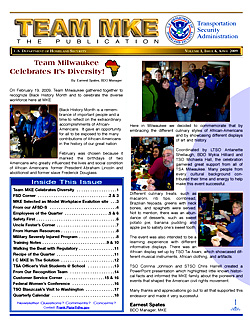
TEAM MKE, a newsletter published by TSA General Mitchell International Airport in Milwaukee, offers readers a hefty collection of articles covering a variety of topics, ranging from local news to human resources information. The April issue welcomes readers with a consistent layout emphasizing substance and style. An employee calendar highlighting important dates and a collection of passenger compliments both reflect a sharp focus to present material geared toward grabbing the newsletter’s primary audience – the workforce.
An archive of featured newsletters is available on iShare in the Communications Central section, which is linked from the home page.
Partnership Leads to Hands-on Training Opportunities
By Dwayne Baird, Office of Strategic Communications/Public Affairs
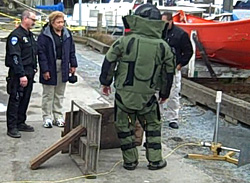
Sonya Proctor, assistant deputy general manager for security training and exercise coordination within the Mass Transit Division, Transportation Sector Network Management, is joined by local and federal law enforcement at a training scenario. Photo by Dwayne Baird
TSA Seattle provided hands-on training to 15 state and local law enforcement bomb disposal units using nearly a dozen scenarios at different venues, including a light rail passenger platform; a ferry with passengers and cars; a passenger train stopped in a tunnel; a city bus loaded with rush-hour commuters; and a rail tank car carrying hazardous chemicals.
The Bomb Squad Response to Transportation Systems Mass Transit/Maritime training, held March 23, was led by the Office of Law Enforcement/Federal Air Marshal Service (OLE/FAMS) and is part of TSA’s ongoing effort to safeguard U.S. critical transportation systems.
Each scenario required teams to evaluate a threat, take the necessary action to neutralize the threat, and bring order back to the affected transportation system.
“Rarely does a training event of this size occur with such precision as this one held in the Seattle area,” said Special Agent in Charge Annmarie Lontz, FAMS, Seattle. “Our interagency cooperation level exceeded expectations of everyone involved.
Officer’s Initiative Takes Her to Headquarters
By Erica Williams, program analyst, IdeaFactory
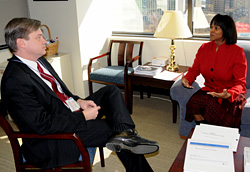
Supervisory TSO Sonja Armstrong talks with Security Operations Assistant Administrator Lee Kair at headquarters. Photo by Rigina Pietrowski
Following a 30-day detail with the IdeaFactory team at headquarters, Sonja Armstrong said one thing she learned during her visit was that “everyone’s opinion matters.”
Armstrong, a supervisory TSO at Arizona’s Show Low Regional Airport, was chosen for the detail after submitting her idea “An Outreach Initiative,” which outlines creative ways to promote IdeaFactory across the workforce.
During the visit, Armstrong presented her idea to program managers and senior leadership. In an effort to encourage employees to use IdeaFactory, she recommended Web conferences and outreach to local newsletter editors.
She emphasized that word of mouth remains the “best way to get more people to use the IdeaFactory.”
“This is a site about bettering the agency,” she said. “If your management team senior level supports something and says it’s okay, TSOs will get involved.”
Kudos & Clips
Managing Technology: Unlocking Ideas
By Carolyn Duffy Marsan, nextgov, April 3, 2009
Great ideas often get trapped in federal bureaucracies, but cutting-edge agencies are tapping into next-gen Web technology as the key to unlocking the power of information sharing. Read more.
As a frequent traveler I would like to comment on the job well done at a Denver checkpoint today. The attitude and professionalism displayed today was outstanding. Thank you for all of your continued efforts in keeping the traveling public safe.
G.P. Potwin, Fort Worth, Texas, to Bob Kapp, customer support and quality improvement manager, Denver International Airport. April 2, 2009.
Secure Flight Program Creates Safer Skies
By Jena Baker McNeill, The Heritage Foundation, April 1, 2009
On March 31, the Department of Homeland Security (DHS) announced the implementation of Secure Flight – a program to screen flight passenger data and flag possible terrorists before they board a commercial airplane. DHS should be commended for implementing such a smart security measure. Secure Flight expands America's capacity to find possible terrorists while minimizing the impact on the airline industry and protecting the rights and privacy of individuals. DHS and Congress should use this program as a model for future airline security efforts and take steps to ensure its full implementation. Read more.
TSA Experience
Houston Officers Bring Songs and Smiles to Veterans
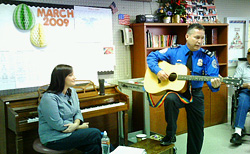
Photo by Shalon Hilts
TSA employees from Houston’s George Bush Intercontinental Airport visited the Michael E. Debakey Veterans Affairs Medical Center March 25-26 to meet with veterans as part of ongoing community outreach efforts. The veteran soldiers shared stories and talked about the friendships formed during military service. TSO Joseph Joblin (pictured) sang and played guitar to a group of veterans in the hospital’s recreation area, as a medical center volunteer looked on. “It was definitely something to remember,” said Joblin.
E-mail your comments and suggestions.
Download Plug-in
Some of the links on this page require a plug-in to view them, which are available below.





